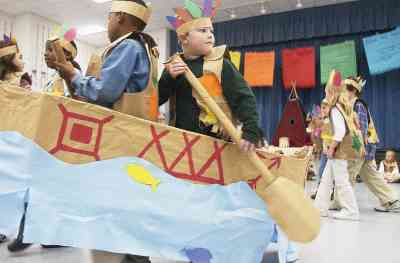By Jessica Goodman
The children wore headbands and beaded shirts in a rainbow of color. With drums they built themselves, the students added their own music to the pow wow.
The event has been celebrated for the past six years at the school.
“It’s changed over the years,” said kindergarten teacher Claire Ungerer. “The children are learning about Native Americans, different tribes from different regions.”
Four groups of students took turns performing Native American-inspired dances, poems and songs.
“I probably like the music, how it calms the children,” said music teacher Karie Hoyle, who helped organize the pow wow. “How they like the drumming and the way they play those flutes.”
Students performed an Inuit poem translated into English called “Ayii, Ayii, Ayii.” The kids acted out the movements of the dance, including crouching down close to the ground.
A second group danced the “Bear Dance” from the Ute tribe, with one student dressed in a brown cape complete with bear ears.
Another group sang with the “Grinding Corn” song from the Hopi Nation. With decorated capes, they danced along with the song to the butterfly dance, which would ensure a good harvest.
The last group performed a ribbon dance, with red, yellow and blue ribbons, to a Lakota song, “Inkpataya.” The kids swirled around with the ribbons, lifting them above their head as they walked around in a circle.
The kids seem to be doing real dances and songs from real tribes. That would be good...but I doubt they're capable of doing them right. Chances are they're making up the dances and songs rather than learning them from a genuine source.
Is it good to be "learning" a dance like this? Native dances often have deeply symbolic meanings that participants learn over years. Dancers often perfrom only at certain times of the year, after days of fasting or other purification rites. I'd say the actual dance is only the tip of the religious iceberg.
This approach would be like teaching Communion by giving students grape juice and cookies from containers labeled "Jesus." Yes, it would give them a facsimile of Communion, but it would be missing the ceremony's heart and soul. It's a tossup whether you'd call it a genuine learning experience, an unhelpful spectacle, or a flat-out mockery.
Bolstering the point are the other things the article mentions: headbands, beaded shirts, flutes, and drums. These are stereotypes that apply only to some Natives, not all. The Inuit didn't wear headbands and beaded shirts, for instance. Despite the different dances, the kids seem to be learning that all Indians are the same.
Kids learn the darndest things
As usual in these kinds of events, the message is that Indians were primitive people of the past. Why not teach students that Native lore is still relevant today? Have them tend a garden with Native farming techniques used today. Or heal an injury with Native medical techniques used today. Or build a house with Native construction techniques used today. This dancing and drumming doesn't send a positive message; it tells kids that Indians were nothing but dancers and drummers.
As usual, dressing up as Indians also sends the wrong message. It tells kids that anyone can be an Indian. That Indians aren't members of political and cultural groups with a unique place in US history. That Indian traditions are as superficial and meaningless as a child's dancing and drumming.
Would you teach African American history by having people dance in grass skirts? Would you teach physics by having people dress up as Einstein and make up equations on a blackboard? Because that's about what these activities amount to.
For more on the subject, see Washington Curriculum Tackles Ignorance and The Right Way to Teach About Indians.
Below: A similar "learning" activity.


3 comments:
The whole drumming thing is best and effectively accomplished by having an actual tribal drum group drop by and play for the kids, and show them the drums.
I think it is a start in the right direction. Yes, they could not authenticate the dancing and singing, but you are assuming that a child from a particular tribe that starts dancing and singing has no room for error in the beginning, that is simply a learning process.
Whether you are 5 or 50 and learning about your own peoples culture, it should be acceptable that you approach your learning not as a "know it all", but rather someone that is fallible and human.
I agree with your ideas about lore, gardens and medicines because it does not LIMIT their grasp of indigenous people to pow-wows.
If there were more schools out there that not only harbored this approach to native peoples, but also included African American, Asian, Latino and even European cultures, this country just might be able to resolve alot of its racial ignorance and strife from within, something that would make America truly unique and actually fulfill its currently overrated patriotic rhetoric proclamations as being a great civilization, until then, patriotism remains guided by religious zeal, greed and militaristic might!
No, Burt, you're assuming that the teachers are teaching the actual dances. (Rather than just saying "dance like a bear" or "wave the ribbons around.") That the teachers know enough to correct the children's inevitable mistakes. And that this is part of some long-term learning process rather than a one-time event.
I don't assume any of these things. That is, I assume they're not true until proven otherwise.
Post a Comment